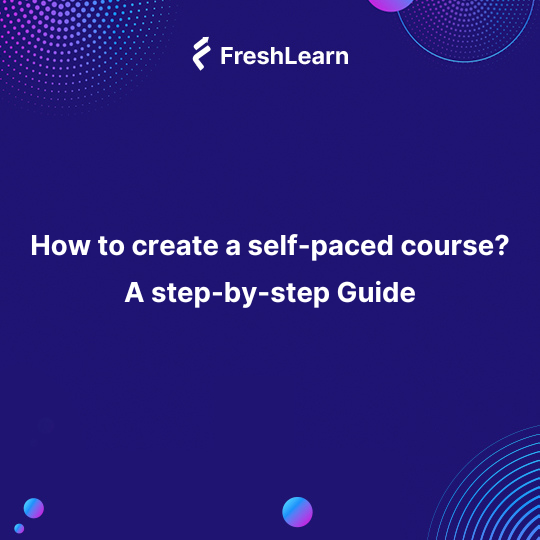
How to create a self-paced course? A step-by-step Guide
Prepare to dive into the intriguing realm of self-paced learning. We're embarking on an exhilarating journey together! Making your self-paced course might seem daunting, but fear not—we've got you covered.
We'll discuss the intricacies of creating a self-paced course in an approachable and casual way within this virtual environment.
You will gain all the required guidance on creating a course that genuinely engages, enlightens, and empowers your students, regardless of whether you are a lifelong learner, an enthusiastic teacher, or an ambitious company owner.
So, make yourself comfortable because we're about to set off on this exciting adventure!
What Is Self-paced Learning?
Self-paced learning is like having your own customized education experience. It's a way of learning where you can call the shots on when and how you learn.
Unlike any traditional semester with fixed schedules, self-paced learning lets you decide the pace and timing. You usually use online resources and interactive tools, which means you can access your course materials whenever it suits you. You can easily enroll in these courses and it takes months to complete the course. Totally up to you!
This method is all about giving you the freedom to review tricky topics, dive into the stuff that interests you, and take your time to grasp the material.
It's like education on your terms. Self-paced learning works for all kinds of learners, and it helps you become more independent, better at managing your time, and truly understand what you're studying.
It's a way to make education fit your needs and abilities!
Create Your Own Self-paced Course Using These Steps
1. Understand Your Audience
Okay, before you go into building your own self-paced course, there's one thing you must take first: get to know your audience.
Consider it your road map for the entire course-making process. You can customize your material to suit your learners like a glove by thoroughly understanding who they are - their goals, what they already know, and how they like to learn.
Do they prefer hands-on activities or visual learning? What challenges might they face? Knowing all of this allows you to craft a course that speaks their language, making it more engaging and effective.
So, whether you're teaching coding or cooking, knowing your audience inside out is the secret sauce for creating a course that hits the mark and delivers a fantastic learning experience.
2. Define Course Objectives
Course objectives are like the North Star of a self-paced course. They're your trusty guideposts that spell out what you'll gain from the course.
Think of them as the course's mission statement, setting the tone and purpose for your learning journey. These objectives lay out the specific knowledge and skills you'll pick up along the way, ensuring that everything in the course lines up with these goals.
So, when instructors define clear and achievable course objectives, they're not just shaping the course content, but they're also giving you a roadmap to follow at your own pace. It's like having a clear path to reach your educational destination.
3. Organize & Create Content
Getting your self-paced course up and running is all about the fun of organizing and creating content!
Think of it as crafting a fascinating adventure for your learners. To begin, divide your course material into bite-sized, easy-to-digest chunks, which we refer to as modules. Each module should have a distinct aim so that your students know what to expect.
The exciting part now begins: bringing your content to life. To make it engaging and educational, use a combination of text, graphics, videos, quizzes, and interactive components.
And remember, keep your style and tone consistent throughout, like a good friend guiding learners on their exciting learning journey.
4. Choose The Right Platform
When you're gearing up to create your own self-paced online courses, think of picking the right platform as your first big decision.
Imagine it like choosing a home for your course—it needs to fit just right. You want something that's easy for your students to use, where you can add all your videos, quizzes, and interactive stuff without a hitch.
Think about it: you wouldn't want your students to struggle with a clunky interface, right? Plus, make sure the platform grows with you, offers good tech support, and doesn’t break the bank.
A good fit here ensures your learners have a smooth and enjoyable learning journey!
5. Design A User-friendly learning experience
Another important step to creating successful self-paced courses is by designing a structured learning environment. To achieve this, it's essential to prioritize simplicity and accessibility.
Begin by crafting a clear and intuitive user interface, ensuring that navigation is straightforward and that all features are easy to find. Break down the course content into manageable sections with concise, engaging, and multimedia-rich complete lessons.
Implement a progress tracking system to help learners monitor their advancement and offer personalized feedback or recommendations based on their performance. Foster a sense of community and support by integrating discussion forums, live Q&A sessions, or peer collaboration opportunities.
Lastly, ensure that the platform is responsive and compatible with various devices to enable learners to access the course anytime, anywhere.
6. Implement Effective Assessments
Assessments serve as the backbone of the learning process, allowing students to gauge their understanding and progress while providing instructors with valuable insights into their performance.
These assessments should be thoughtfully designed to align with the course objectives, ensuring they measure the desired skills and knowledge. They should be diverse in format so that you can encompass quizzes, submit assignments, projects, etc. to cater to various learning styles.
Regular feedback loops are essential, enabling students to track their growth and make informed adjustments.
Moreover, assessments should be fair and balanced, neither too easy nor too difficult, to motivate learners and maintain their engagement throughout the self-paced journey.
7. Market & Promote
Effective marketing and promotion are essential not only to make your self-paced course known and appreciated but to offer financial aid as well. Imagine your course as a hidden gem, and your goal is to unveil its brilliance to the world.
Just like sharing your excitement about a fantastic restaurant with friends, you need to spread the word about your course.
Identify your target audience - those who will benefit the most from your course. Then, leverage various platforms such as social media and email marketing to create buzz.
Engage influencers who align with your course topic to amplify your reach. Essentially, market your course passionately, as if you're divulging an incredible secret to the world.
The key lies in connecting what you've created with those who truly need it!
8. Manage & Update Your Course
To create an effective self-paced course, it's crucial to continually manage and update your content. This step is like the course's lifeblood, ensuring its relevance and value for your learners.
Regular management involves tracking learner progress, gathering feedback, and addressing any issues or questions promptly. Furthermore, keeping the course material up to date is critical to represent the most recent industry trends, technology, or best practices.
By changing and refining your content, you improve the overall learning experience, transforming your course into a valuable resource that will be in high demand for a long time.
Conclusion
In essence, crafting a self-paced course is akin to embarking on an exciting journey where you serve as the knowledgeable guide.
To easily create an exceptional learning experience for your students, follow the steps that we've outlined in the blog.
Designing a self-paced course offers a fantastic opportunity to impart your expertise, whether you're an educator, entrepreneur, or simply someone enthusiastic about sharing knowledge.
The key lies in meticulous planning, creating engaging content, and remaining receptive to feedback and enhancements.
If you're eager to take the next step in sharing your expertise, consider utilizing FreshLearn—an all-in-one platform for creators.
FreshLearn empowers you to transform your knowledge into various offerings such as courses, cohorts, live workshops, and digital downloads, enabling you to kickstart a successful online business.
What sets FreshLearn apart is its commitment to supporting creators with 0% commission on sales, fostering collaborative learner engagement, and offering bespoke learner-side features like assignments, quizzes, completion certificates, points earning and redemption, reviews, comments, and quizzes to enhance learner satisfaction.
Don't miss out on this opportunity to make your mark in the world of online education. Start your journey with FreshLearn today!


